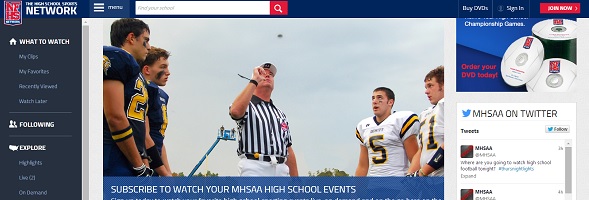
This Week on MHSAA.TV
October 1, 2014
Six schools taking part in the MHSAA’s School Broadcast Program are among nine student broadcast programs across the state receiving grants from the Detroit Sports Broadcasters Association Grant Fund and Scholarship Program.
The grants will be used by the schools to purchase equipment for their ongoing video production work. SBP schools receiving the grants are: Escanaba High School, Haslett High School, Hillman High School, Mason High School, Montrose High School and Whittemore-Prescott High School.
“The Detroit Sports Broadcasters Association has a rich tradition of supporting young men and women pursuing sports and news broadcasting careers,” said George Eichorn, Executive Director of the DSBA. “We are very proud to recognize students and programs from Detroit to Escanaba.”
Added Vicki Foley, DSBA President: “We are extremely happy to give back to our communities as part of our mission to support education in this unique and powerful way. We are also very grateful for the continued support of our members, sponsors, and donors who recognize the importance of providing guidance and funding to our future sportscasters, writers, and reporters through their dedication and generous contributions.”
The School Broadcast Program gives members an opportunity to showcase excellence in their schools by creating video programming of athletic and non-athletic events; with students gaining skills in announcing, camera operation, directing/producing and graphics. The program also gives schools the opportunity to raise money through advertising and viewing subscriptions.
A year-high 73 events were streamed by schools last week, with activities ranging from daily announcements to school board meetings, live sporting events and National Honor Society inductions. As many as 60 MHSAA member schools annually participate in the program, which is in its sixth year.
Here’s the schedule of School Broadcast Program members planning to cover varsity competition this week for broadcast at MHSAA.tv (As of Sept. 30). The following events will be shown live on a subscription basis:
Menominee at Escanaba – Girls Volleyball – Tuesday, 7 p.m.
Dowagiac at Plainwell – Boys Soccer – Thursday, 7 p.m.
Atlanta at Hillman – Football – Friday, 7 p.m.
Oscoda at Lincoln Alcona – Football – Friday, 7 p.m.
Allegan at Plainwell – Football – Friday, 7 p.m.
Oscoda at Lincoln Alcona – Boys Soccer – Monday, 5 p.m.
Events listed below are currently available on-demand from last week:
Football
- Oscoda vs. Tawas
- Comstock Park vs. Coopersville
- Onaway vs. Gaylord St. Mary
- Montrose vs. Goodrich
- AuGres-Sims vs. Atlanta
- Whittemore-Prescott vs. Lincoln Alcona
- Negaunee vs. Gwinn
- Stanton Central Montcalm vs. Newaygo
- Cedar Springs vs. Grand Rapids Northview
- Calumet vs. Hancock
- Hemlock vs. Alma
Volleyball
- Haslett vs. DeWitt
- Newberry vs. Pickford
- Comstock Park vs. Grand Rapids West Catholic
- Onaway vs. Fife Lake Forest Area
- Cedar Springs vs. Wyoming
- Hillman vs. Oscoda
- Rogers City vs. Fairview
- East Lansing vs. Lansing Sexton
- Grayling vs. Charlevoix
- Escanaba vs. Marquette
- Posen vs. Hale
Soccer
- Haslett vs. Mason
- Chesaning vs. Essexville Garber
- Grayling vs. Elk Rapids
- East Lansing vs. St. Johns
- Lincoln Alcona vs. Oscoda
Cross Country
- Tawas, Hale, Standish-Sterling at Oscoda
MHSAA Perspective: In this week's edition, our John Johnson highlights former Michigan high school athletes with multiple records in the NFHS High School Record Book - Record Holders
MHSAA.tv Highlights: This week's package includes clips from the Newaygo/Stanton Central Montcalm and Alma/Hemlock football games and Grayling/Charlevoix volleyball match.

Today in the MHSAA: 10/24/24
By
Geoff Kimmerly
MHSAA.com senior editor
October 24, 2024
1. BOYS SOCCER No. 2 Flint Powers Catholic edged No. 3 Imlay City in a Division 3 Regional Semifinal – Port Huron Times Herald
2. BOYS SOCCER No. 5 Mason advanced in its Division 2 Regional with a shootout win over Bloomfield Hills Cranbrook Kingswood – Oakland Press
3. BOYS SOCCER Top-ranked Pontiac Notre Dame Prep downed Frankenmuth 4-1 in Division 3 – WJRT
4. BOYS SOCCER No. 4 Allendale downed Coldwater 3-0 in a Division 2 Regional Semifinal – WTVB
5. VOLLEYBALL Division 1 honorable mention Traverse City Central finished a season sweep of rival West – Traverse City Record-Eagle
6. VOLLEYBALL Alpena came back from losing the first set to defeat Gaylord in four on Senior Night – Alpena News
7. VOLLEYBALL Hancock earned a road sweep at Lake Linden-Hubbell – Houghton Daily Mining Gazette
8. VOLLEYBALL Midland Bullock Creek and Beaverton earned Jack Pine Conference sweeps – Midland Daily News

